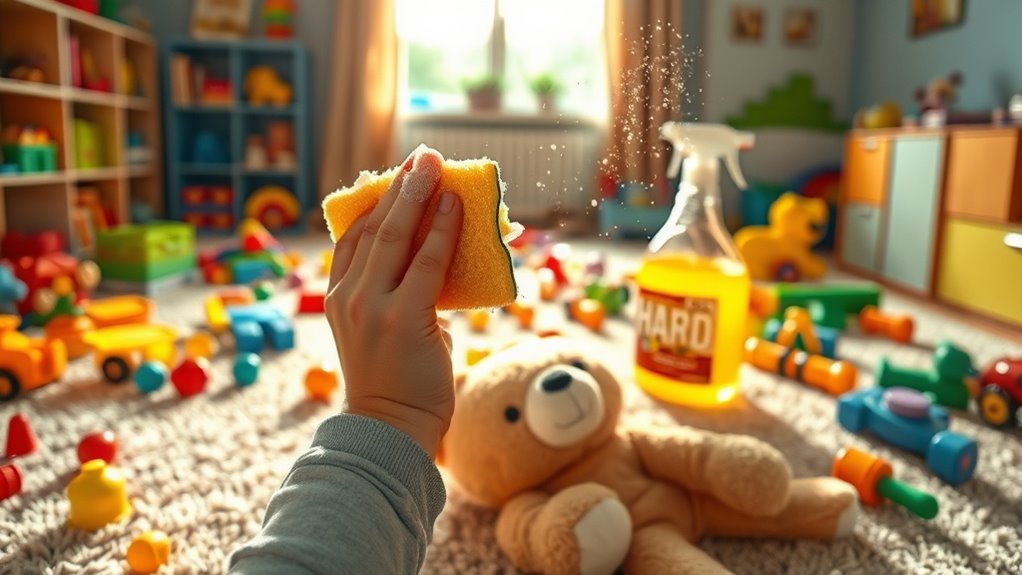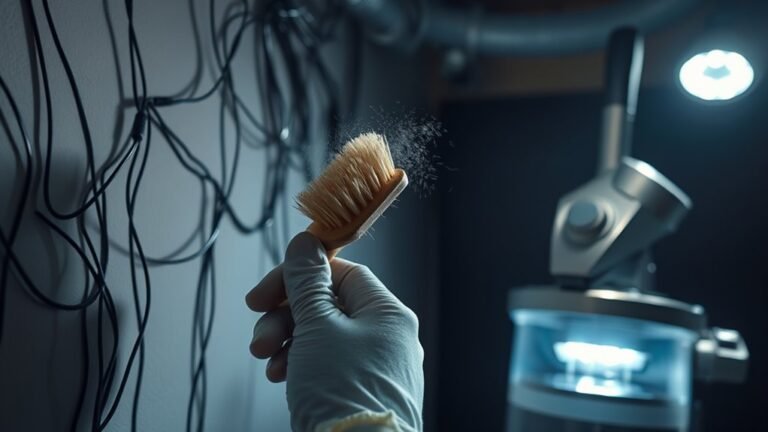Mistakes to Avoid When Cleaning Your Toys
When cleaning your toys, avoid using harsh chemicals that can damage plastics and fabrics. Don’t submerge electronic toys in water—use a damp cloth instead. Always follow the manufacturer’s instructions to prevent harm. Avoid soaking plush toys too much, as excess water can cause mold and shape loss. Don’t skip regular cleanings or use abrasive tools that scratch surfaces. Make sure toys dry completely, and store them in well-ventilated spaces. Keeping these tips in mind will help you maintain your toys longer and safer.
Using Harsh Chemicals That Damage Materials

Although it might seem like a good idea to use strong cleaners to disinfect toys, you should avoid harsh chemicals that can damage their materials. When you opt for aggressive substances, you risk triggering unwanted chemical reactions that degrade plastics, fabrics, or painted surfaces. Your toys deserve cleaning methods that respect their material compatibility, ensuring they stay intact and safe. Instead of reaching for industrial-strength solutions, choose gentle, non-toxic cleaners designed for delicate items. This way, you maintain freedom from worry about discoloration, warping, or brittleness caused by incompatible chemicals. Taking care in selecting cleaning agents lets you preserve your toys’ quality without sacrificing cleanliness, giving you peace of mind and the freedom to enjoy them longer.
Submerging Electronic Toys in Water
One major mistake you should avoid is submerging electronic toys in water. Even if a toy claims some level of water resistance, it’s not a green light to dunk it fully. Water resistance doesn’t guarantee full protection, and immersing the toy risks damaging delicate circuits inside. Prioritizing electronic safety means keeping these toys dry or cleaning them with a damp cloth instead. Submerging can lead to short circuits, corrosion, or permanent failure, stripping away the freedom to enjoy your toy without hassle. To maintain your electronic toys’ longevity and functionality, stick to gentle surface cleaning methods. This way, you respect the toy’s design and preserve its performance, letting you play freely without worrying about water damage.
Ignoring Manufacturer’s Cleaning Instructions

You should always read the label carefully before cleaning your child’s toys. Using the recommended cleaners guarantees you won’t damage the materials or leave harmful residue. Plus, following drying guidelines helps keep the toys safe and ready for play.
Read Label Carefully
Before you start cleaning your child’s toys, make sure you read the label carefully to avoid damaging them. Understanding the label importance is key to preserving the toy’s quality and ensuring safety. Good reading comprehension lets you follow specific guidelines that manufacturers provide, preventing costly mistakes.
Here’s what to keep an eye on when checking labels:
- Recommended cleaning methods (hand wash, machine wash, surface wipe)
- Suitable cleaning agents and what to avoid
- Drying instructions (air dry, no direct sunlight)
- Warnings about water temperature limits
- Material-specific care tips (plastic, fabric, electronic parts)
Taking a moment to read labels gives you the freedom to clean effectively without risking wear or harm to your child’s favorite toys.
Use Recommended Cleaners
Choosing the right cleaner is crucial to keep toys safe and intact. When you ignore the manufacturer’s cleaning instructions, you risk damaging delicate toy materials or compromising safety. Not all cleaning supplies are made equal; some can be too harsh or leave harmful residues. Stick to the recommended products designed specifically for the toy’s material—whether it’s plastic, fabric, or wood. This guarantees thorough cleaning without causing wear or discoloration. Plus, using the right supplies helps preserve the toy’s quality and longevity, giving you freedom to enjoy them worry-free. So, always check and follow the cleaning guidelines provided. It’s a small step that protects both the toy and your peace of mind.
Follow Drying Guidelines
Once you’ve selected the right cleaner for your toys, the next step is to follow the drying guidelines exactly as the manufacturer recommends. Ignoring these instructions can lead to damage or mold growth, restricting your toys’ lifespan and your freedom to enjoy them. Proper drying techniques and moisture control are essential to keep your toys safe and ready for use.
Remember to:
- Air dry toys in a well-ventilated area
- Avoid direct sunlight unless specified
- Use a soft cloth to gently pat dry sensitive parts
- Do not use heat sources like hairdryers unless allowed
- Store toys only when completely dry to prevent moisture buildup
Respecting these steps guarantees your toys stay in top shape without limits.
Using Excessive Water on Plush Toys

You might think using lots of water is the best way to clean plush toys, but it can actually cause water damage and ruin their shape. It’s important to use just enough moisture and follow proper drying techniques to keep them safe. Let’s explore how to clean your plush toys without soaking them.
Risk of Water Damage
Although plush toys seem sturdy, using too much water during cleaning can cause serious damage. When you soak them excessively, the fabric’s water absorption overwhelms the stuffing, leading to trapped moisture that’s tough to control. This lack of moisture control invites mold growth and unpleasant odors, ruining your toy’s freedom to stay fresh and safe.
Here’s what you risk with over-wetting your plush toys:
- Mold and mildew development deep inside
- Faded colors and weakened fabric fibers
- Misshapen stuffing that won’t bounce back
- Rusting of any internal metal parts
- Longer drying times risking bacterial growth
Keep water use minimal to protect your toy’s integrity and enjoy the freedom of a clean, fresh plush without damage.
Proper Drying Techniques
When excessive water soaks a plush toy, proper drying becomes essential to prevent damage like mold or fabric distortion. You want to avoid trapping moisture inside, so it’s important to use drying methods that promote good air circulation. After squeezing out excess water gently, place the toy in a well-ventilated area, avoiding direct heat sources that can warp materials. Fans or open windows can boost air flow, speeding up drying and keeping the fabric fresh. Skip the dryer unless the care label confirms it’s safe—high heat can ruin stuffing and fabric. By mastering these drying techniques, you maintain your toy’s shape and longevity, giving you the freedom to clean without worry or damage.
Skipping Regular Cleaning Sessions
Regularly cleaning your child’s toys is essential to keep germs and dirt at bay. Skipping regular cleaning sessions can quickly lead to buildup that affects toy hygiene and your child’s health. Without a consistent cleaning schedule, bacteria and allergens multiply, making playtime less safe. Staying on top of cleaning lets you enjoy freedom from worries about hidden germs. Here’s what happens when you neglect regular cleaning:
- Toys become sticky and grimy
- Allergens trigger sneezing or itching
- Germs spread between family members
- Play areas look cluttered and dirty
- Your child’s immune system faces unnecessary challenges
Using Abrasive Tools That Scratch Surfaces
If you want to keep toys looking their best, steer clear of abrasive tools that can scratch surfaces. Abrasive materials like rough sponges or harsh brushes might seem effective, but they can damage the finish and wear down delicate parts. When you use these abrasive tools, you risk compromising the toy’s appearance and durability. Instead, opt for soft cloths or gentle brushes designed for surface protection. By choosing the right cleaning tools, you preserve the toy’s original look and extend its life, giving you the freedom to enjoy it longer. Remember, protecting surfaces during cleaning isn’t just about aesthetics — it’s about maintaining the quality and value of your cherished toys. Avoid abrasive materials to keep everything in top shape.
Failing to Dry Toys Thoroughly After Cleaning
Choosing the right tools to protect your toys during cleaning only gets you halfway there. If you fail to dry toys thoroughly after cleaning, you’re leaving the door wide open for mold growth and bacteria breeding. Moisture trapped in crevices or soft materials creates the perfect environment for these unwelcome guests, compromising your toys’ safety and longevity. To keep your toys fresh and ready for action, make sure you:
Proper drying after cleaning is essential to prevent mold and bacteria, ensuring your toys stay safe and long-lasting.
- Use microfiber cloths to absorb moisture quickly
- Air-dry toys in a well-ventilated area
- Pay special attention to joints, seams, and fabric
- Avoid stacking toys while wet to prevent trapped moisture
- Consider using a fan or gentle heat source for faster drying
Drying thoroughly isn’t just maintenance—it’s freedom from worry and grime.
Storing Toys Without Proper Ventilation
Even though it might seem convenient, storing toys without proper ventilation can lead to musty odors, mold growth, and material deterioration. You want your toys to stay fresh and last, so understanding ventilation importance in toy storage is key. Without airflow, moisture traps, causing damage you could easily avoid.
| Issue | Cause | Solution |
|---|---|---|
| Musty Odors | Poor airflow | Use breathable containers |
| Mold Growth | Trapped moisture | Store in dry, ventilated areas |
| Material Deterioration | Humidity buildup | Avoid airtight bins |
| Stains | Condensation | Regularly air out toys |
| Unpleasant Smell | Inadequate ventilation | Use mesh or fabric bags |
Prioritize ventilation in storage to keep your toys free and fresh, preserving your freedom to enjoy them anytime.
Frequently Asked Questions
How Often Should I Deep Clean My Toys?
Did you know bacteria can double every 20 minutes on uncleaned surfaces? For your peace of mind and health, your deep cleaning frequency should be at least once a month, especially if you use toys regularly. Following toy maintenance tips like thorough washing with warm water and mild soap helps keep them safe and fresh. Staying on top of this routine lets you enjoy your freedom without worrying about germs or damage.
Can I Use Natural Cleaning Products on All Toys?
You can use natural cleaning products on many toys, but it really depends on the toy materials. Some materials, like silicone or glass, handle natural cleaning methods well, while porous materials like certain plastics or fabrics might absorb moisture or get damaged. Always check the manufacturer’s guidelines and test a small area first. This way, you’re free to keep things fresh without risking your toy’s quality or safety.
What Is the Safest Way to Disinfect Toys During Flu Season?
When flu season sneaks in like a shadow, you want to shield your toys with the safest disinfecting methods. You can use a gentle mix of water and mild soap or a diluted bleach solution to zap germs without harsh chemicals. Steam cleaning works wonders too, giving you flu precautions that let your kids play freely and safely. Just make sure toys dry completely to keep those pesky bugs at bay.
Are There Toys That Don’T Require Cleaning?
You might think some toys don’t need cleaning, but even soft toys and electronic toys benefit from a good wipe-down. Soft toys can trap dust and germs, so occasional washing keeps them fresh without ruining their fluff. Electronic toys need gentle cleaning to avoid damage but still get grime off. While you want freedom to play without fuss, keeping your toys clean helps you enjoy them longer and stay healthy.
How Do I Clean Toys With Batteries Safely?
Oh sure, just dunk your battery-powered toy in water and see if it magically survives—that’s battery safety at its finest! To keep your freedom-loving spirit intact, gently wipe the toy’s surface with a damp cloth, avoiding water near battery compartments. Check your toy materials to guarantee they won’t be ruined by moisture. Always remove batteries if you’re soaking parts, and dry everything thoroughly before reassembling. Stay safe and keep your toys—and your freedom—intact!






